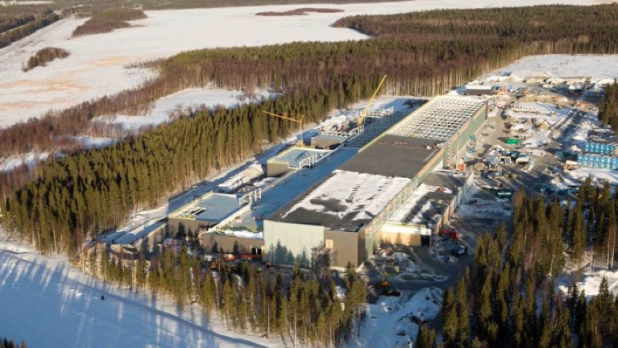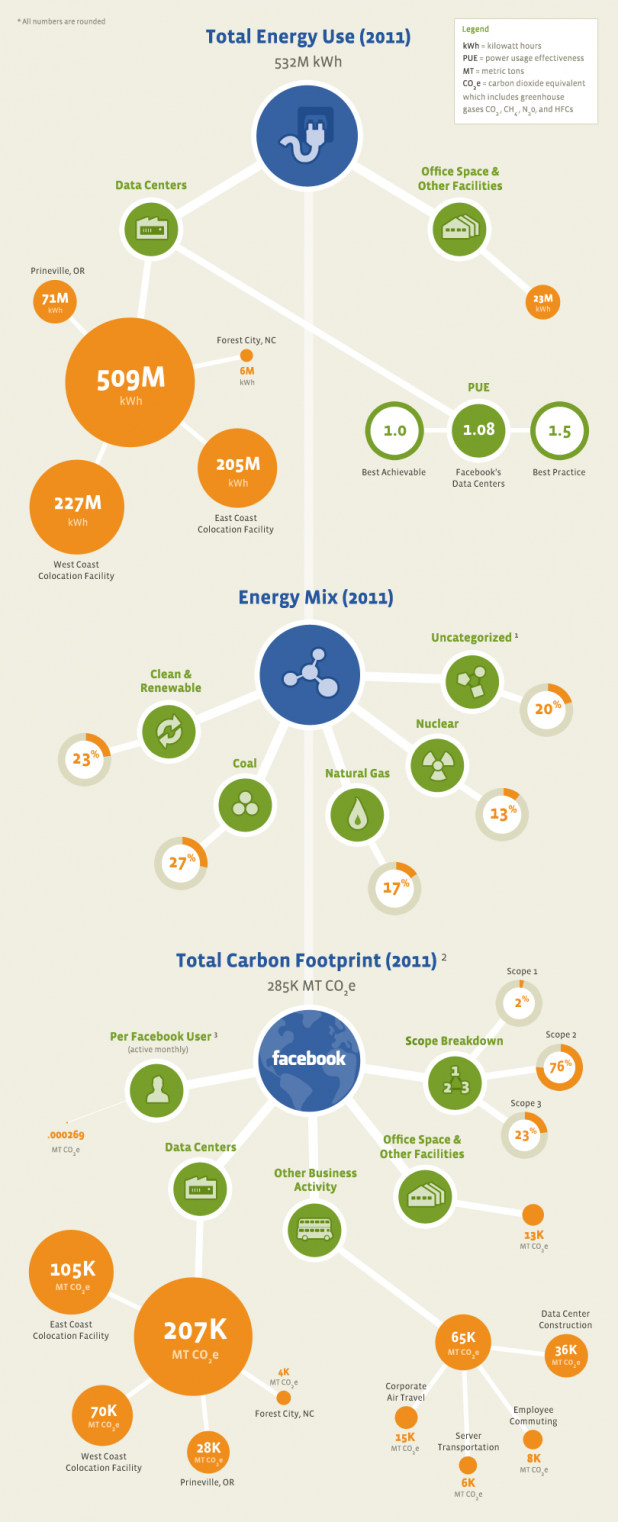[caption id="attachment_3225" align="aligncenter" width="618"]

Facebook's Swedish data center, during its construction.[/caption] Facebook revealed the energy use for its worldwide data centers last week, with the company adding that it was still on track to derive at least 25 percent of its energy mix from clean and renewable sources by 2015. Facebook said that its total overall power use was 532 million kWh, of which 509 million kWh derived from its data centers. The company has built three data centers of its own: in Prineville, Or., Forest City, N.C., and its most recent facility in Lulea, Sweden. However, the bulk of the company's power use in 2011—432 of the 532 kWH, or 81 percent—comes from a pair of co-located data centers on the East and West Coast. The Web giant did not provide any 2010 figures for comparison. Overall, the company claimed a
PUE (power usage effectiveness) of 1.08. Facebook’s greenhouse gas emissions, or CO2e (known as the carbon dioxide equivalent, which includes greenhouse gases CO2, CH4, N2O, and HFCs) totaled approximately 285,000 metric tons. That includes emissions from data centers, office space, employee commuting, employee air travel, data center construction and server transportation. That won some praise from
Greenpeace, which criticized Facebook in 2010 for its dependence on coal-powered sources of electricity. "Facebook has committed to being fully renewably powered, and today's detailed disclosure and announcement of a clean energy target shows that the company means business and wants the world to follow its progress," Greenpeace International senior IT analyst Gary Cook wrote in a statement. Facebook leads the Open Compute project, an effort to design "vanity free" server nodes that the project claims are 38 percent more power-efficient and 28 percent cheaper to build than competing solutions. Those servers are being used to outfit the Prineville data center. Facebook also said that its so-called energy mix, or the sources from which it derives its energy, included 23 percent clean and renewable, 27 percent coal, 17 percent natural gas, 13 percent nuclear and 20 percent uncategorized, meaning it was purchased on the spot market and could come from any number of sources. Facebook's Lulea data center, currently under construction, uses the naturally cooled air near the Arctic Circle to help cool its racks of servers. "In the short-term, reducing our impact and significantly altering our energy mix will be challenging,"
Facebook wrote in a corporate blog posting. "The reality is that as a fast-growing company our carbon footprint and energy mix may get worse before they get better.” The company’s latest data center will apparently help with its clean-energy goals, added the posting. “When we bring our Lulea, Sweden, data center online in 2014, we expect to see a steady increase in the clean and renewable sources powering our data center operations,” it read. “And we’ve set a company goal to derive at least 25 percent of our energy mix from clean and renewable sources by 2015.” Greenpeace, meanwhile, has turned its attention to Apple, which it insists lacks the same transparency as Facebook and other computing giants. In mid-July, Greenpeace gave Apple a "clean energy score" of 22.6 percent, up from 15.3 percent, based on its own internal metrics. The environmental group said that, although Apple has pledged to make its data centers "coal free," it lacks a "realistic path" to get there. Greenpeace did acknowledge that solar panels and fuel cells will provide 60 percent of the electricity for the first phase of its data center in North Carolina, and will turn to regional renewable energy providers for the remaining 40 percent. Meanwhile, for your viewing pleasure, an infographic of Facebook's energy use:
 Images: Facebook
Images: Facebook  Facebook's Swedish data center, during its construction.[/caption] Facebook revealed the energy use for its worldwide data centers last week, with the company adding that it was still on track to derive at least 25 percent of its energy mix from clean and renewable sources by 2015. Facebook said that its total overall power use was 532 million kWh, of which 509 million kWh derived from its data centers. The company has built three data centers of its own: in Prineville, Or., Forest City, N.C., and its most recent facility in Lulea, Sweden. However, the bulk of the company's power use in 2011—432 of the 532 kWH, or 81 percent—comes from a pair of co-located data centers on the East and West Coast. The Web giant did not provide any 2010 figures for comparison. Overall, the company claimed a PUE (power usage effectiveness) of 1.08. Facebook’s greenhouse gas emissions, or CO2e (known as the carbon dioxide equivalent, which includes greenhouse gases CO2, CH4, N2O, and HFCs) totaled approximately 285,000 metric tons. That includes emissions from data centers, office space, employee commuting, employee air travel, data center construction and server transportation. That won some praise from Greenpeace, which criticized Facebook in 2010 for its dependence on coal-powered sources of electricity. "Facebook has committed to being fully renewably powered, and today's detailed disclosure and announcement of a clean energy target shows that the company means business and wants the world to follow its progress," Greenpeace International senior IT analyst Gary Cook wrote in a statement. Facebook leads the Open Compute project, an effort to design "vanity free" server nodes that the project claims are 38 percent more power-efficient and 28 percent cheaper to build than competing solutions. Those servers are being used to outfit the Prineville data center. Facebook also said that its so-called energy mix, or the sources from which it derives its energy, included 23 percent clean and renewable, 27 percent coal, 17 percent natural gas, 13 percent nuclear and 20 percent uncategorized, meaning it was purchased on the spot market and could come from any number of sources. Facebook's Lulea data center, currently under construction, uses the naturally cooled air near the Arctic Circle to help cool its racks of servers. "In the short-term, reducing our impact and significantly altering our energy mix will be challenging," Facebook wrote in a corporate blog posting. "The reality is that as a fast-growing company our carbon footprint and energy mix may get worse before they get better.” The company’s latest data center will apparently help with its clean-energy goals, added the posting. “When we bring our Lulea, Sweden, data center online in 2014, we expect to see a steady increase in the clean and renewable sources powering our data center operations,” it read. “And we’ve set a company goal to derive at least 25 percent of our energy mix from clean and renewable sources by 2015.” Greenpeace, meanwhile, has turned its attention to Apple, which it insists lacks the same transparency as Facebook and other computing giants. In mid-July, Greenpeace gave Apple a "clean energy score" of 22.6 percent, up from 15.3 percent, based on its own internal metrics. The environmental group said that, although Apple has pledged to make its data centers "coal free," it lacks a "realistic path" to get there. Greenpeace did acknowledge that solar panels and fuel cells will provide 60 percent of the electricity for the first phase of its data center in North Carolina, and will turn to regional renewable energy providers for the remaining 40 percent. Meanwhile, for your viewing pleasure, an infographic of Facebook's energy use:
Facebook's Swedish data center, during its construction.[/caption] Facebook revealed the energy use for its worldwide data centers last week, with the company adding that it was still on track to derive at least 25 percent of its energy mix from clean and renewable sources by 2015. Facebook said that its total overall power use was 532 million kWh, of which 509 million kWh derived from its data centers. The company has built three data centers of its own: in Prineville, Or., Forest City, N.C., and its most recent facility in Lulea, Sweden. However, the bulk of the company's power use in 2011—432 of the 532 kWH, or 81 percent—comes from a pair of co-located data centers on the East and West Coast. The Web giant did not provide any 2010 figures for comparison. Overall, the company claimed a PUE (power usage effectiveness) of 1.08. Facebook’s greenhouse gas emissions, or CO2e (known as the carbon dioxide equivalent, which includes greenhouse gases CO2, CH4, N2O, and HFCs) totaled approximately 285,000 metric tons. That includes emissions from data centers, office space, employee commuting, employee air travel, data center construction and server transportation. That won some praise from Greenpeace, which criticized Facebook in 2010 for its dependence on coal-powered sources of electricity. "Facebook has committed to being fully renewably powered, and today's detailed disclosure and announcement of a clean energy target shows that the company means business and wants the world to follow its progress," Greenpeace International senior IT analyst Gary Cook wrote in a statement. Facebook leads the Open Compute project, an effort to design "vanity free" server nodes that the project claims are 38 percent more power-efficient and 28 percent cheaper to build than competing solutions. Those servers are being used to outfit the Prineville data center. Facebook also said that its so-called energy mix, or the sources from which it derives its energy, included 23 percent clean and renewable, 27 percent coal, 17 percent natural gas, 13 percent nuclear and 20 percent uncategorized, meaning it was purchased on the spot market and could come from any number of sources. Facebook's Lulea data center, currently under construction, uses the naturally cooled air near the Arctic Circle to help cool its racks of servers. "In the short-term, reducing our impact and significantly altering our energy mix will be challenging," Facebook wrote in a corporate blog posting. "The reality is that as a fast-growing company our carbon footprint and energy mix may get worse before they get better.” The company’s latest data center will apparently help with its clean-energy goals, added the posting. “When we bring our Lulea, Sweden, data center online in 2014, we expect to see a steady increase in the clean and renewable sources powering our data center operations,” it read. “And we’ve set a company goal to derive at least 25 percent of our energy mix from clean and renewable sources by 2015.” Greenpeace, meanwhile, has turned its attention to Apple, which it insists lacks the same transparency as Facebook and other computing giants. In mid-July, Greenpeace gave Apple a "clean energy score" of 22.6 percent, up from 15.3 percent, based on its own internal metrics. The environmental group said that, although Apple has pledged to make its data centers "coal free," it lacks a "realistic path" to get there. Greenpeace did acknowledge that solar panels and fuel cells will provide 60 percent of the electricity for the first phase of its data center in North Carolina, and will turn to regional renewable energy providers for the remaining 40 percent. Meanwhile, for your viewing pleasure, an infographic of Facebook's energy use:  Images: Facebook
Images: Facebook